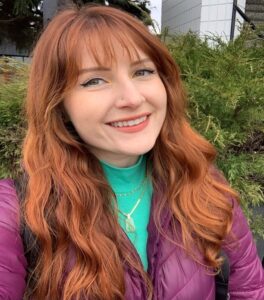Listen to the author read this article (10:53)
The summer and fall of 2021 was deeply unsettling for Sabrina Guzman Skotnitsky as fire swept through parts of the interior of British Columbia, followed by an atmospheric river that tore up chunks of the Coquihalla highway. Her family in Vancouver regularly drove the Coquihalla to visit Sabrina’s grandparents in the Shuswap region but that all came to a stop after the environmental disasters.
“It was devastating for me personally because the beautiful area that I was used to going to since I was a kid was changed very drastically. It was the first tangible climate change impact to reach me and my family.”
Sabrina’s grandparents were evacuated from their home for a month because of the intensity of the wildfire smoke. When she was finally able to visit them, she remembers the devastation alongside the Coquihalla.
“I just remember the stark image of the snow-covered mountains and the dead trees sticking up that had been burned in the summer. And so that was really what inspired the painting.”
Her painting ‘Winter On The Coquihalla’ is one of several artistic offerings that appear in a zine produced by a group of young people in Vancouver known as Solastalgia. The word ‘solastalgia’ is broadly defined as the distress caused by environmental change on people in their home environment.

One of the group’s co-founders, Renmart Buhay, says they wanted to focus on eco-anxiety since there wasn’t a lot of space for young people, aged 18 to 30, to talk about their emotions outside of home and work.
The 27 year-old works in public health research. Six years ago he moved to B.C. from the Philippines where he says he experienced firsthand the impact of climate change.
About two years ago, Renmart and a group of his peers formed Solastalgia, creating a platform for young people to express their feelings about climate justice and the environment through poetry, personal reflections, paintings and other visual arts.

Renmart Buhay
“We wanted to find a way to spark conversations using the arts and for people to connect at an emotional level. The environment is changing in ways you can’t control. We do have a lot of things we might want to say or talk about in terms of the climate crisis. Sometimes it can be difficult to talk about these things with different generations – parents, grandparents or someone younger than you.”
Sabrina Guzman Skotnitsky understands the emotional burden that climate issues put on young people.

Sabrina Guzman Skotnitsky
“It’s very much the mental health aspect of it and me being concerned about my future, and also because I work in the climate space I often feel overwhelmed because of the enormity of the problem and can feel like my contributions are too small or not happening fast enough.”
At the age of 26 years, she has been part of the climate justice movement for over 10 years. She was a member of the group Kids For Climate Action as a teenager and has helped to organize campaigns, protest in marches, and lobby politicians for climate change policies.
Now working on a Master’s degree at the University of Victoria, Sabrina’s research focuses on how visual art making can support young people and process their climate emotions. Her own art making has helped her cope but she sees even greater benefits by connecting with others, especially young people.
“You are surrounded by people who feel similar to you and you’re reminded that you’re not the only person who cares about this, you’re not alone. That’s a very supportive environment. I am so motivated and inspired to do this thesis research because we need tools to sustain our activism over a longer term. So art-making is talking to other people, journaling. Other mental health tools are actually necessary if we want to achieve that big goal of climate justice.”
Through her own artistic expression, writer and teacher Kiran Shoker has also found fulfilment in navigating the challenges of climate change. She has written two pieces for Solastalgia’s debut zine including a poem titled ‘Dirt,’ a reflection on our relationship with the planet.
“We continue to talk about the Earth as if we are separate from it. That’s the part that needs to be understood. We’re not saving something that’s separate from us. We’re actually saving something that is part of ourselves and that we are integral to. Art can communicate these things.”
The 31 year old has degrees in both Science and English. She currently teaches English at an East Vancouver high school. While there is much focus on the advancement of technology to solve climate problems, Kiran believes the human connection with Earth also needs to be further appreciated and strengthened.
“What’s happening for some reason (is that) people aren’t falling in love with Earth any more. People need to feel a sense of love for this Earth and bring them toward taking action. So the first thing I try to do is to have my students fall in love with places they love to be, and that can be done through writing.”

Kiran Shoker
In one assignment, she asked students to research, visualize and reflect on nature, and then write a love letter to nature.
“Art really has the emotional quality that motivates people to take action in a way that learning about the atrocities from a very scientific perspective can actually push them towards anxiety and remove themselves from that situation.”
Anxiety about climate change is showing up in numerous studies that document the emotional impact on young people. In one Canadian research project which surveyed 1,000 young people aged 16 to 25 years, 78 percent of respondents reported that climate change was affecting their overall mental health. 37 percent reported that their feelings about climate change negatively impacted daily functioning.
Solastalgia’s volunteer members are well aware of the incidence of eco-anxiety amongst their peers. In addition to the production of zines, the group has organized several workshops such as a poetry writing event where both young and old, including elders associated with the David Suzuki Foundation discuss climate issues.
“We want to normalize these kinds of emotions. These emotions aren’t a bad thing…grief, anxiety and sadness. It’s important to express these feelings. It’s a normal part of being a human being,” RRenmart Buhay notes.
“I would say the pandemic was the biggest break I took. It gave me space to recover and to re-evaluate what I wanted to focus on. When I do art making, I am not thinking about climate change at all. It’s healthy not to think about it all the time,” Sabrina Guzman Skotnitsky adds.
At the same time, Sabrina is hopeful about the future.
“A lot of things give me hope which is great because I did not feel this way a few years ago but especially seeing all the work others are doing, especially other young people because when I was mostly getting overwhelmed it’s when I think I need to do everything but when I’m reminded there are people doing things that they are really good at, we’ll be able to address these things.”
As a teacher and poet, Kiran Shoker, sees education as a key part in getting youth involved in the climate change movement.
“In education we often teach poetry that is revolutionary in nature, about different social causes that students might be coming up against but somehow writing about the earth…the earth is only taught from a scientific perspective and one of the things I learned early on there’s a really big rise in eco-anxiety and one of the issues with people not taking action is they haven’t really fallen in love with earth.”
Kiran like others who have contributed works to Solastalgia, remains positive about the challenges ahead.
“I am an innately hopeful person I don’t want to succumb to the constructs of this world. Why I have hope is that things do change. Our society is different from the way it was 20, 40, 60 years ago. I know we have the propensity to change. So yes, it can happen, so we can make change, we can demand change, we can use our vote. That’s what really gives me hope.”
 Bill Stovin is a retired journalist with a long career at CBC-TV and radio and in private radio as well as a former Communications Director in government.
Bill Stovin is a retired journalist with a long career at CBC-TV and radio and in private radio as well as a former Communications Director in government.


